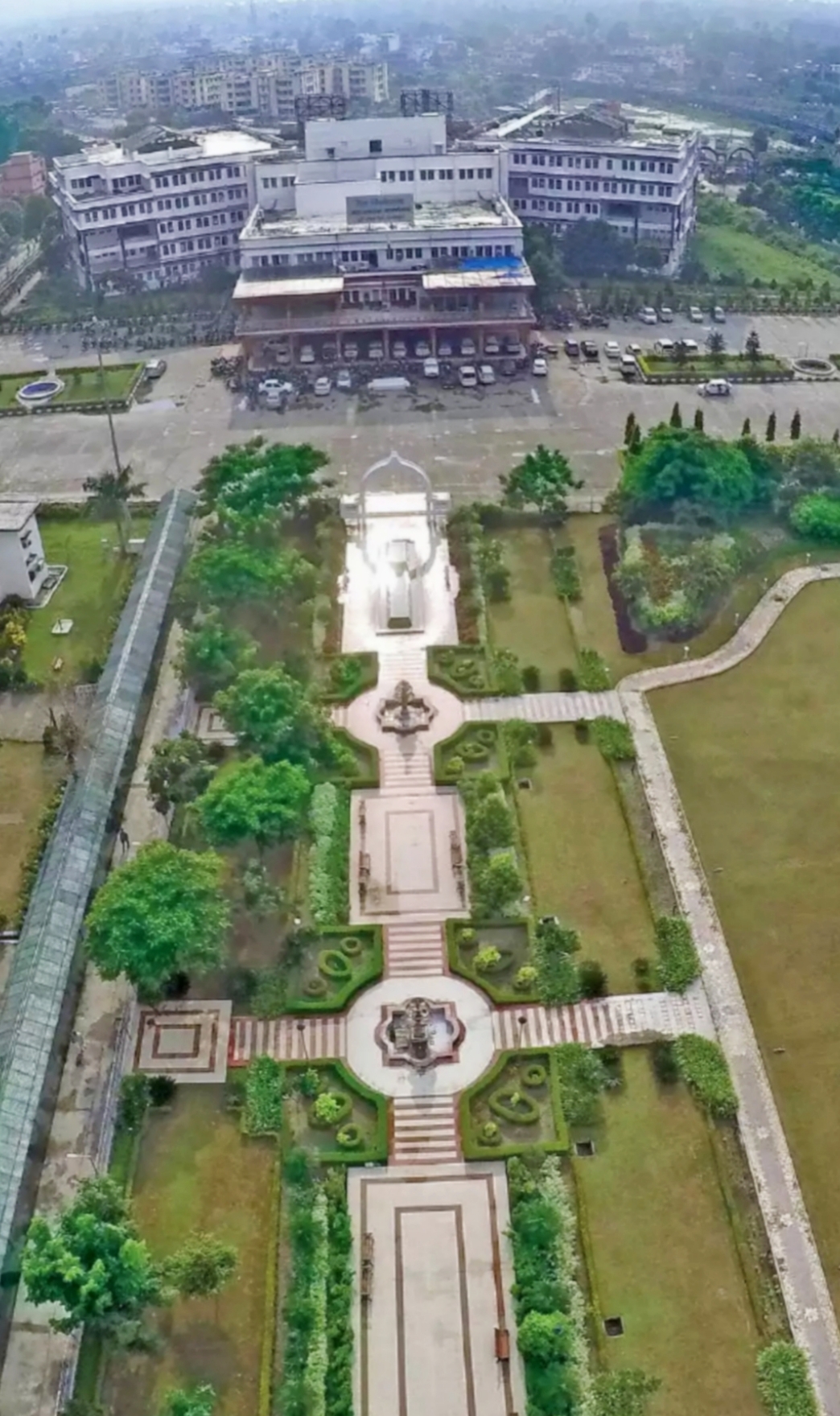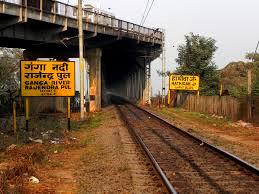|
Mokama Ghat
Mokama Ghat is a village about four kilometres east of Mokama on the bank of the river Ganga in Bihar, India. Importance The Hindi word "Ghat" means "bank of a river which is used by people for bathing or transportation of passengers and goods". Mokama Ghat was used for ferrying cargo and passengers by ships across the river to the north eastern parts of India. It was linked by rail to Mokama, and was once an important railway station under the Danapur division of the East Central Railway Zone. It was also linked by road. The passengers and goods would be carried by either road or rail to Mokama Ghat, where they would be transported by ship across the river to Simaria Ghat. History Until the first half of 20th century, Mokama Ghat was an important trade and transport link in eastern India. Malabika Chakrabarti mentions the congestion at Mokama railway Ghat in May 1897 as one of the reasons for the failure of the supply of grains during the Bengal famine of 1896–97 in her book ... [...More Info...] [...Related Items...] OR: [Wikipedia] [Google] [Baidu] |
Mokama
Mokama is a town and a municipal council in barh of Patna district in the Indian state of Bihar. It is located east of Patna on the southern banks of the river Ganges. Mokama is the connecting town of north and south Bihar and has 2nd highest amount of lentil production in India. It emerged as an industrial area in State of Bihar after independence. Indian independence movement The place where the revolutionary freedom fighter Prafulla Chaki was martyred is marked by a shaheed gate. People commemorate the anniversary of his death every year. Lalldin Saheb is yet another well known freedom fighter from Mokama who contributed in freedom struggle and was sentenced to jail during British rule. He worked for the welfare of the people of Mokama throughout his life. Had major contribution in reopening the Bharat Wagon Engineering Company of Mokama that is source of income of thousands of families. Transport Mokama is connected to all the major cities of India by rail and road. Hat ... [...More Info...] [...Related Items...] OR: [Wikipedia] [Google] [Baidu] |
Ganges
The Ganges ( ) (in India: Ganga ( ); in Bangladesh: Padma ( )). "The Ganges Basin, known in India as the Ganga and in Bangladesh as the Padma, is an international river to which India, Bangladesh, Nepal and China are the riparian states." is a trans-boundary river of Asia which flows through India and Bangladesh. The river rises in the western Himalayas in the Indian state of Uttarakhand. It flows south and east through the Gangetic plain of North India, receiving the right-bank tributary, the Yamuna, which also rises in the western Indian Himalayas, and several left-bank tributaries from Nepal that account for the bulk of its flow. In West Bengal state, India, a feeder canal taking off from its right bank diverts 50% of its flow southwards, artificially connecting it to the Hooghly river. The Ganges continues into Bangladesh, its name changing to the Padma. It is then joined by the Jamuna, the lower stream of the Brahmaputra, and eventually the Meghna, forming the major ... [...More Info...] [...Related Items...] OR: [Wikipedia] [Google] [Baidu] |
Bihar
Bihar (; ) is a state in eastern India. It is the 2nd largest state by population in 2019, 12th largest by area of , and 14th largest by GDP in 2021. Bihar borders Uttar Pradesh to its west, Nepal to the north, the northern part of West Bengal to the east, and with Jharkhand to the south. The Bihar plain is split by the river Ganges, which flows from west to east. On 15 November 2000, southern Bihar was ceded to form the new state of Jharkhand. Only 20% of the population of Bihar lives in urban areas as of 2021. Additionally, almost 58% of Biharis are below the age of 25, giving Bihar the highest proportion of young people of any Indian state. The official languages are Hindi and Urdu, although other languages are common, including Maithili, Magahi, Bhojpuri and other Languages of Bihar. In Ancient and Classical India, the area that is now Bihar was considered the centre of political and cultural power and as a haven of learning. From Magadha arose India's first empire, ... [...More Info...] [...Related Items...] OR: [Wikipedia] [Google] [Baidu] |
East Central Railway Zone
The East Central Railway (abbreviated ECR) is one of the 19 railway zones in India. It is headquartered at Hajipur and comprises Sonpur, Samastipur, Danapur, Pt. Deen Dayal Upadhyaya, and Dhanbad divisions. History First set up on 8 September 1996 with headquarters at Hajipur, Bihar, East Central Railway became operational on 1 October 2002 by carving out areas from Eastern and North Eastern Railway zones currently consists of the divisions viz. Dhanbad, Danapur, Mughalsarai of Eastern Railway and Sonpur and Samastipur of North Eastern Railway. The last 13 years of its existence has been full of challenges and every obstacle was dealt in a dedicated manner despite constraints of work force and infrastructure. ECR, has a vast network of 5402.693 track kilometers and 3707.988 route kilometers encompassing the states of Bihar, Jharkhand, Uttar Pradesh and Madhya Pradesh. Out of the route, have been electrified. ECR has been lifeline for the people in its expanse and i ... [...More Info...] [...Related Items...] OR: [Wikipedia] [Google] [Baidu] |
Rajendra Setu
Rajendra Setu, or Simaria Bridge, is a bridge across the Ganges that was the first to link the northern and southern portions of the state of Bihar. The location of the bridge was based on the work of M. Visvesvaraya, who was more than 90 years old at the time. In a wheelchair, he visited the bridge site on the special request of Bihar's chief minister, Shri Krishna Sinha. It was the first bridge over the Ganges to be built in independent India (after 1947). The road-cum-rail bridge near Hathidah in Patna district and Simaria in Begusarai district was inaugurated in 1959 by Jawaharlal Nehru, prime minister of India, and Shri Krishna Sinha. The bridge was constructed by Braithwaite, Burn & Jessop Construction Company. It is about long and carries a two-lane road and a single-line railway track. A new bridge, carrying the four-lane NH 31 and double-track rail, 25 metres upstream from the existing rail and road bridge, was planned in 2011. The construction of the new parall ... [...More Info...] [...Related Items...] OR: [Wikipedia] [Google] [Baidu] |
Jim Corbett
Edward James Corbett (25 July 1875 – 19 April 1955) was a British hunter, tracker, naturalist, and author who hunted a number of man-eating tigers and leopards in the Indian subcontinent. He held the rank of colonel in the British Indian Army and was frequently called upon by the Government of the United Provinces of Agra and Oudh, now the Indian states of Uttar Pradesh and Uttarakhand, to kill man-eating tigers and leopards that were preying on people in the nearby villages of the Kumaon- Garhwal Regions. He authored ''Man-Eaters of Kumaon'', ''Jungle Lore'', and other books recounting his hunts and experiences, which enjoyed critical acclaim and commercial success. He became an avid photographer and spoke out for the need to protect India's wildlife from extermination. Early life Edward James Corbett was born on 25 July 1875 of British ancestry in the town of Nainital in Kumaon division, Uttarakhand, India. He grew up in a large family of sixteen children and was the e ... [...More Info...] [...Related Items...] OR: [Wikipedia] [Google] [Baidu] |
Prafulla Chaki
Prafulla Chandra Chaki ( bn, প্রফুল্ল চাকী, ''Prafulla Chaki'' alias Dinesh Chandra Roy) (10 December 1888 – 1 May 1908) was an Indian revolutionary associated with the Jugantar group of revolutionaries who carried out assassinations against British colonial officials in an attempt to secure Indian independence. Prafulla and Khudiram Bose tried to assassinate the district judge, Mr. Douglas Kingsford, by throwing bombs at the carriage in which Kingsford was supposed to travel, but he was not in the carriage, and two British women were killed. Prafulla committed suicide when he was about to be arrested by the Police. Khudiram was arrested and tried for the murder of the two women and sentenced to death. Mahatma Gandhi denounced the violence and regretted the deaths of two women. He stated "that the Indian people will not win their freedom through these methods". However, Bal Gangadhar Tilak in his newspaper '' Kesari'', defended the two young men a ... [...More Info...] [...Related Items...] OR: [Wikipedia] [Google] [Baidu] |
_1_by_N._A._Naseer.jpg)



.jpg)